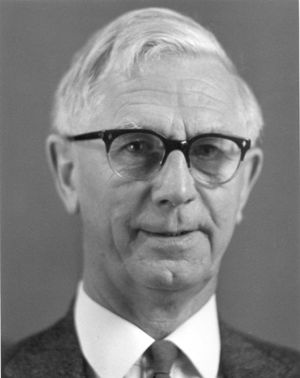Sir Charles William Oatley, OBE, FRS
1904-96.  Professor of Electrical Engineering and developer of one of the first commercial scanning electron microscopes.
Professor of Electrical Engineering and developer of one of the first commercial scanning electron microscopes.
Charles Oatley stands with Manfred von Ardenne as one of the two great pioneers of scanning electron microscopy. His involvement with the SEM began immediately after World War II when, fresh from his wartime experience in the development of radar, he perceived that new techniques could be brought to bear which would overcome some of the fundamental problems encountered by von Ardenne in his pre-war research on the instrument. Oatley's pioneering work led directly to the launch of the world's first series production instrument - the Stereoscan - in 1965.
Oatley was educated at Bedford Modern School and St John's College, Cambridge. He spent twelve years teaching at King's College London before starting work on radar and electronics at the Air Defence Research and Development Establishment, throughout the Second World War. In 1945 he was appointed to a Lectureship in the Cambridge Engineering Department and a Fellowship at Trinity. His interest in a scanning electron microscope was first aroused when he learned of von Ardenne's pre-war work in Germany and that of Zworykin in the USA in the early 1940s.
Oatley was a director of the English Electric Valve Company from 1966 to 1985. In 1969 he was elected to the Royal Society and knighted in 1974. He was also a founder member of the Royal Academy of Engineering.
He was awarded the Howard N. Potts Medal in 1989, and received an Honorary Doctorate from the University of Bath in 1977.
| Memorial inscription | Translation |
|
CHARLES WILLIAM OATLEY EQ. AVR HVIVS COLLEGII PER LII ANNOS SOCIVS DECESSIT A.S. MCMXCVI AET. SVAE XCIII |
Sir Charles William Oatley was a Fellow of this College for fifty-two years. He built a microscope which greatly exceeded the magnifying power of its predecessors, enabling him to display the details of atoms, thus revealing to human sight for the first time the tiniest of tiny particles in three dimensions. He also promoted the subject of Engineering diligently in the University. He died in 1996 at the age of ninety-two. |
Charles William OatleyBrass located on the north wall of the Ante-Chapel. |
|
|
|
PREVIOUS BRASS |
|
NEXT BRASS Carl Frederick Abel Pantin |
| Brasses A-B | Brasses C-G | Brasses H-K | Brasses L-P | Brasses R-S | Brasses T-W |

